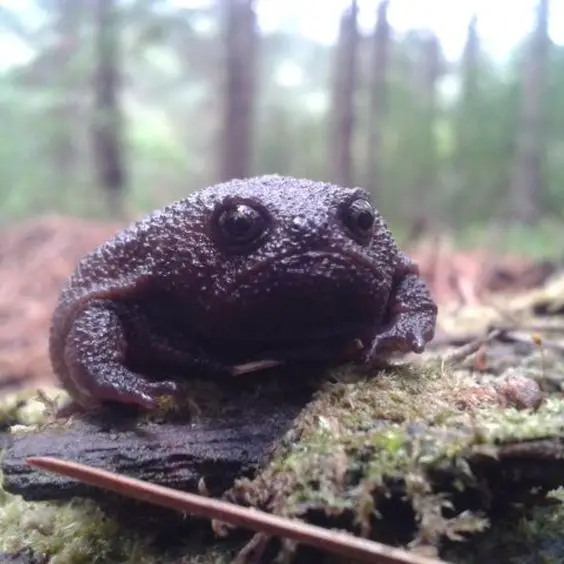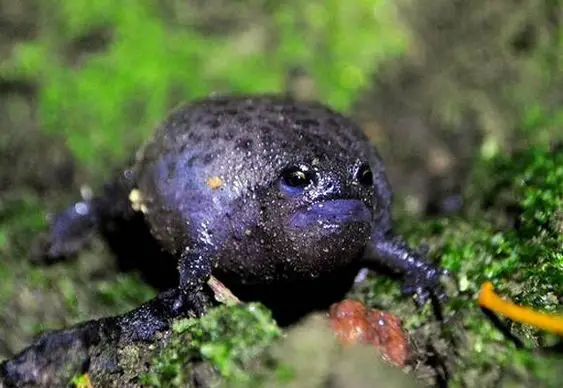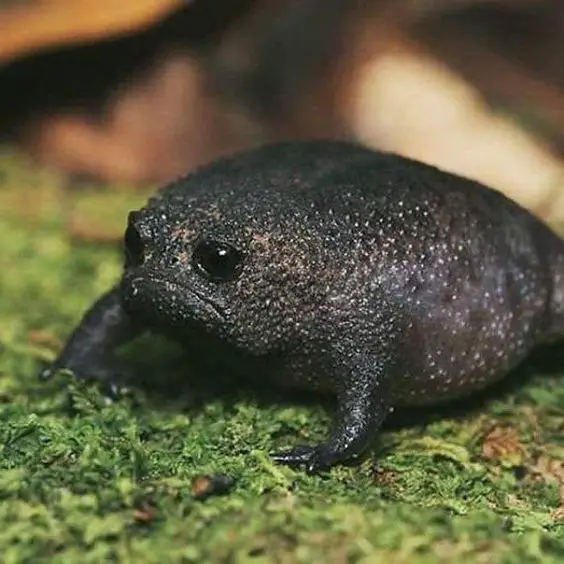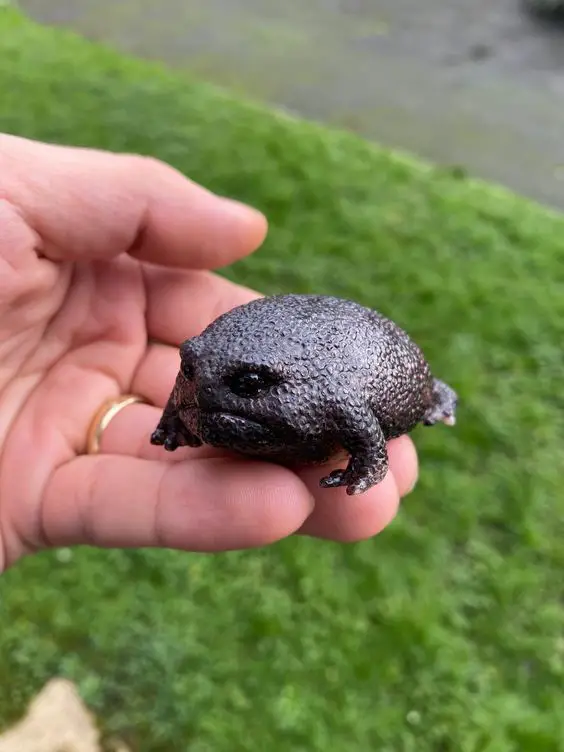Breviceps fuscus, or the Black Rain Frog is a distended shape animal native to the southern coast of South Africa. Black Rain frogs, also known as brown short-headed frogs, spend most of the day in their burrows eight inches in length. They do not need much care and maintenance, but setting up an environment similar to their natural habitat is very difficult.
However, Black Rain Frogs are not usual pets. They are untamed and are native to a region of South Africa that is not famous for amphibian exchange. People are not allowed to capture them and do their trade, making their trade unavailable.
Overview
Common Name | Black rain Frog, Plain Rain Frog, Brown Short Headed frog, Tsitsikamma Rain Frog |
Scientific Name | Breviceps fuscus |
| Habitat | South Africa, on the slope of Cape Fold Belt |
Life Span | of 4 to 15 years |
Size of Adult | Grow up to 2 inches |
Nutrition | Small insects and larvae |
Tank size | At least 10 gallons per frog |
Experience level | Intermediate |
Origin

Black Rain Frog is a species of frog that belongs to the Brevicipitidae family. They are native to the southern slope of Cape Fold Belt, at an elevation of 3300 feet. They are also known as Tsitsikamma rain frogs because of the Tsitsikamma National Park, a locality where they can be found.
Black Rain Frog is a nocturnal animal that spends the daytime sleeping in its burrows and comes out during the night to scavenge food.
Black Rain Frog is a burrowing species. It does not require the availability of open water to live. It digs a burrow and finds moisture and an essential thing: privacy.
Physical Appearance
The Black Rain Frogs are dark brown or nearly black. They have round balloon-shaped bodies with short limbs and toes. Their skin contains widely spaced granules or pitting and is slick to touch.
Black Rain Frogs’ puffed-up body is an evolutionary characteristic. It acts as a defense mechanism. They fill up their body with air and become more significant to repel the predator in case of any danger. This defense mechanism also helps them as their dilated body resist being pulled out of the burrow by predators.
The female rain frog is more significant than the male rain frog. Another main difference between male and female frogs is that females secrete a sticky substance during reproduction on their backs.
Size and lifespan
A fully grown Black Rain Frog has a snout-vent length of (40-51 cm). They have a life span of 4 to 15 years in the wild, and this period depends on the number of predators in the locality. They can live in captivity for four years, depending on the provided environment and conditions. Appropriate conditions are necessary for their survival in captivity.
The IUCN International Union for Conservation of Nature stated that Black Rain Frog is not a Concerned species. It means that they are in abundance in the wild and not an endangered species.
Nature and Temperament of Black Rain Frog
Black Rain frogs are calm and peaceful, quickly getting scared. When they get frightened, they let out a distinctive high-pitched scream. They also puff up their body like a balloon in case of danger and when they get scared as a defense. Being nocturnal animals, they spend the daytime sleeping in their burrows, only coming out at night to scavenge food.
Male and female are calm and enjoy each other’s company but only keep them together when you need to breed them.
As the Black Rain Frog can quickly get scared, you need to keep them in captivity’s calm and peaceful environment in captivity.
Can You have Black Rain Frog as a pet?
Yes, people can have them as pets. They require low maintenance and upkeep, but they can only survive in an environment similar to their natural habitat.
The Black Rain Frogs require an adequate environment to thrive in captivity. If someone plans to have them as a pet, they need to be familiar with their diet and requirements. Appropriate conditions like temperature, humidity, and the substrate are necessary for their enclosure. They may die early if proper conditions aren’t available.
Housing Black Rain Frogs
Black Rain Frogs can be housed in an environment similar to their natural habitat in a terrarium or vivarium. You don’t need an aquarium as they don’t need a constant open water supply.

However, appropriate conditions are necessary for their survival no matter which type of enclosure you are choosing for them. As they are burrowing animals, enough solid substrate should be present for frogs to dig a burrow up to eight inches.
Selection of Enclosure
Before selecting an enclosure, consider that these frogs are not climbers and are very playful. They need enough horizontal space to roam about. So, an enclosure of 10 gallons is appropriate for these Black Rain Frogs.
Burrowing animals need enough space and solid substrate to dig a burrow, so make sure the enclosure should be tall enough to provide them space to burrow.
Lighting
Being nocturnal animals, they don’t need dark light. They spend the daytime in their burrows and only come out at night. So, a dim light works well for them.
Temperature and Humidity
Appropriate conditions like Humidity and temperature are essential for the frog’s health. Here is a list of equipment needed to maintain suitable temperature and humidity in the grogs enclosure:
- Under tank heater UTH
- Thermometer\Hygrometer combo
- Thermostat
The Mediterranean climate is Black rain frogs’ natural habitat where rain seldom occurs. Temperature ranges between 50 to 75 F, and humidity level is 55 to 80%, So the area is primarily dry, not humid.
How to maintain heat in the Black Rain frog habitat?
There are many ways to heat the frog’s enclosure, but the most appropriate is using UTH under tank heaters. They are mostly placed under the tanks, but it’s better to put the mat on the side to prevent your frog from directly heating when they burrow in the substrate.
It is best to place the heating mat on the side of the enclosure as it creates an environment similar to their natural habitat. A thermostat is used to vary the temperature inside the chamber after setting the UTH with a sensor. Place the detector near the heating mat. It will change the temperature inside the enclosure by turning on and off the UTH when the temperature gets too cold or hot.
A thermometer or hygrometer is also used to monitor the temperature inside the enclosure. Make sure that the humidity level doesn’t exceed 80%. Use a spray bottle to create humidity inside the chamber.
Filling the enclosure with Substrate
While filling the chamber with the substrate it is important to take the concept of their natural habitat. The best substrate for a Black Rain frog is blended soil with leaf litter. Soil should be of high quality and need to be bought from the store to ensure its quality. Sphagnum and sand should be mixed with the soil. It helps the soil retain water and maintain the humidity of the enclosure.
Black Rain Frogs are nocturnal animals, live in burrows, and only came out during the night. So, being burrowing animals they need enough substrate to dig tunnels and burrow through the soil.
Small vegetation 10 inches tall can also be used in the enclosure. Like ferns and bromeliads can be a good choice as they maintain moisture and provide a good hiding spot, Black rain frogs can also damage the small plants. Instead of real small plants, small plastic plants can also be added to the enclosure.
How to Clean Black Rain Frog Enclosure
Proper cleaning and upkeep of the enclosure are needed to ensure the hygiene of the frog. Proper upkeep includes the removal of remaining food and old substrate.
The chamber should be cleaned once a month. Many pet holders use another temporary tank while cleaning the enclosure of the substrate.
For cleaning the enclosure, you should use pet-safe cleaning products. Another good choice is 50% distilled vinegar and 50% water.

What does the Black Rain frog eat?
Black Rain Frogs’ primary source of nutrition is small insects like flies, moths, ants, and spiders. They are tiny animals that reach only the size of 2 inches so they eat insects smaller than the distance between their eyes.
Black Rain Frogs eat a variety of insects to ensure their health and prevent them from health issues. The main source of protein for Black Rain Frogs is crickets. If they eat crickets bigger in size they can go through impaction. Impaction can cause blockage of the intestine which can cause death.
Black rain frogs need to be fed 2 to 3 times per week. After this, there should be no roaming insects present around them. Don’t feed them wild insects because they can cause several diseases to them.
Handling Black Rain Frogs
Black Rain Frogs can be handled easily without any concern because they are not poisonous. They easily get frightened so touch them with care. If they feel any danger they puff up their body in defense. Don’t try to pull them out of the burrow because it can cause stress to them.
Health Concerns
Black Rain Frogs are not susceptible to any particular diseases but they can get common bacterial, fungal, and viral diseases. A couple of those diseases are listed below:
- Chilomastix is a disease caused by a flagellate found in the frog’s intestine. It reaches the intestine when the frogs drink water contaminated with feces. It can be treated by Dewormers.
- Ranavirus is a DNA virus. It causes virus-3 in the frog due to which molarity rate reaches 90 percent. Skin ulceration and swelling of the limbs are the main symptoms of this disease. Isolation of infected frogs is necessary as no treatment for this disease is present.
Are Black Rain Frogs Poisonous?
Black Rain Frogs are not poisonous animals. You can handle them without any concerns. They are small animals that can get scared easily, and puff up their bodies as a defense against danger.
Black Rain Frogs Breeding
Getting all information about the mating process is necessary to breed them in captivity.
The mating process starts when the male attracts females toward them by creating a mating call that sounds like a chirp. The female frog secretes a sticky substance that helps males latch for mating.
Females after mating lay 40-45 eggs per nest. They cover their nest with a layer containing empty 20-30 eggs that protect the actual eggs from any danger as the predators go for top layer eggs first.
Unlike other frogs, there is no tadpole stage. Eggs hatch directly into an adult frog. Reproduction can also take place in captivity but for this appropriate conditions that resemble their natural habitat is very important. In captivity, during mating, if any frog dilates its body and screams you need to separate them from each other.
Baby Black Rain Frogs
Black Rain Frogs don’t have a tadpole stage, unlike other frogs. Eggs hatch directly into the Baby frogs. Baby frogs are self-independent, they eat and play on their own. In captivity, you need to take care of their food and natural habitat. Baby rain frogs usually eat more food than adult frogs as they are in developmental stages.
Where to buy Black Rain Frog?
Black Rain frogs are not usually and easily available in the pet trade. They are hard to find online and in stores.
Black Rain Frogs are found in South Africa and caught by frog breeders. Their trade is not flourishing in South Africa so it is not possible to see them in the market anytime.
Their cost is not clear as frog breeders catch them and sell them at a premium. There is a risk of having diseases while catching them wild. They need proper veterinary examination before anyone can have them as their pet.
Conclusion
Black Rain Frogs trade is not common. If you have managed to have them as a pet, it is necessary to know them for their proper upkeep and maintenance.
The most challenging thing is to create an environment for them similar to their natural habitat which ensures their burrowing activity.







